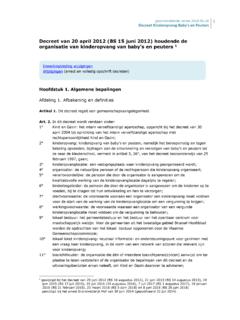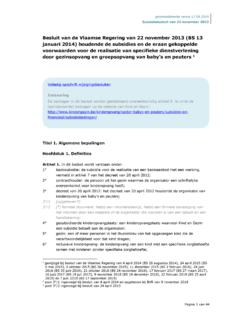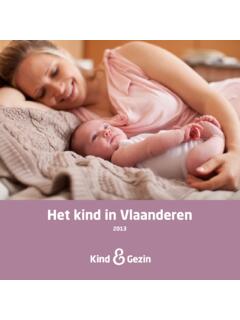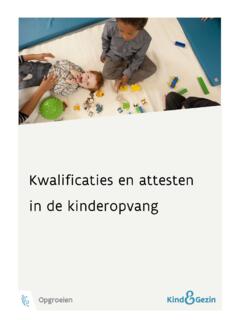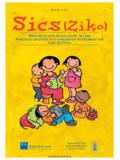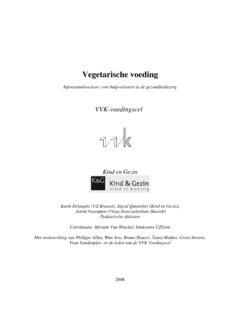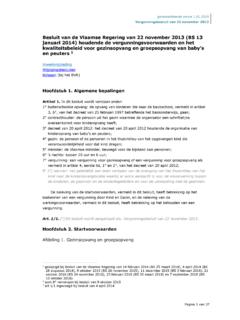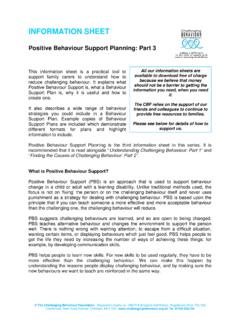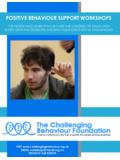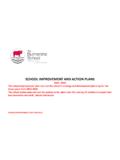Transcription of Sics (Ziko) - Kind en Gezin
1 Well-being and Involvement in Care A process-oriented Self-evaluation Instrument for Care Settings sics ( ziko ) ISB: 978-90-77343-76-8 Research Centre forExperiential EducationLeuven University handleiding eng ziko 118-01-2006 16:48:43 Title:Well-being and Involvement in Care Settings. A Process-oriented Self-evaluation :Ferre Laevers (Ed.) in collaboration with: Mieke Daems, Griet De Bruyckere, Bart Declercq, Julia Moons, Kristien Silkens, Gerlinde Snoeck, Monique Van KesselOriginal dutch version Zelfevaluatie-Instrument voor Welbevinden en Betrokkenheid van Kinderen in de :Hannah LaeversIllustrations:Kathleen Amant 2005 Kind & Gezin and Research Centre for Experientel Education FURTHER INFORMATION For further information we refer to and (the website of the Research Centre for Experiential Education). TRAINING&SUPPORT In connection with sics a video-training pack titled Observation of well-being and involvement in babies and toddlers containing 40 fragments has been developed (see website Cego).
2 The Research Centre also provides training sessions for advisers, heads of settings and practitioners to introduce sics . Interested organisations in the and elsewhere can contact: Ludo Heylen by e-mail for inquiries about this program handleiding eng ziko 218-01-2006 16:55:42 sics [ ziko ]manualProject Leader:Prof. Dr. Ferre LaeversResearch team:Mieke Daems, Griet De Bruyckere, Bart Declercq , Julia Moons, Kristien Silkens, Gerlinde Snoeck, Monique van KesselWell-being and Involvement in CareA Process-oriented Self-evaluation Instrumentfor Care SettingsResearch Centre forExperiential EducationLeuven University handleiding eng ziko 318-01-2006 16:55:43 sics A Process-oriented Self-evaluation Instrument for Care settings Manual ORIGINAs part of its policy to improve the quality of care provisions, Kind & Gezin [Child & Family] - the Flemish agency that supervises the care sector - took the initiative to develop an instru-ment that had to meet three requirements: (1) it has to serve as a tool for self-assessment by care settings.
3 (2) it must take the child and its experience of the care environment as the main focus to look at quality and (3) it must be appropriate for the wide range of care provision including care for the under three s in day care centres and family care as well as the out of school care for children up to the age of instrument has been developed by a team based at the Research Centre for Experiential Education (Leuven University Belgium) under the supervision of Dr. Ferre Laevers. sics is based on a conceptual framework that has been developed during the last decades in the con-text of innovative work in pre-school, primary, secondary and higher education. Two indicators of quality are central to this experiential approach: well-being and involvement . Well-being refers to feeling at ease, being spontaneous and free of emotional tensions and is crucial to secure mental health . Involvement refers to being intensely engaged in activities and is consi-dered to be a necessary condition for deep level learning and development.
4 SELF-ASSESSMENTSiCs is designed to help settings to get aware of their strengths and weaknesses when it comes to create the best possible conditions for children to develop. Although heads of settings or coordinators are collecting most of the data through observation, every supervisor in the settings is actively involved in the procedure of self-assessment. The process of refl ection and action is seen as the responsibility of the whole STEPSThe procedure for self-evaluation contains three steps:STEP 1: assessment of the actual levels of well-being and involvement (scanning of the groups); STEP 2: analysis of the observations (explanation of the levels observed); STEP 3: selection and implementation of actions to improve quality. A MANUAL AND FORMSThis manual will help to become familiar with the concepts behind sics ( ziko ). It comes with a number of forms and guidelines to complete them. The term supervisor in the manual refers to everyone who is engaged in the care of children including the child care family, the child care worker, the practitioners in after-school care, use of this self-evaluation instrument not only leads to signifi cantchanges in the settings as such.
5 It also contributes to the professional development of practitioners. Through the process they learn to take the perspective of the child in their approach and because of this to create optimal conditions for the social-emotional and cognitive developmentof handleiding eng ziko Sec2:118-01-2006 16:55:43A VIEW ON QUALITYOne can look at quality from different angles. Here we describe three possible ways to get a view on the quality of THE APPROACHHere, you want to gain more insight into the practice as it is shaped by responsible staff and supervisors: you can focus on the available space, how it is arranged and which ma-terial is offered. You can also observe the activities on offer (which and how much) and how supervisors relate to children. The way things are organised, whether everything is safe, whether there is suffi cient guidance, etc. are also relevant topics when it comes to assess the OBSERVATION IN SETTING A The material on offer in this group of toddlers is very limited.
6 In the morning there are blocs and cuddly toys. In the afternoon the children want to play in the sandbox, but they are not allowed. Only the slide and the play house are available at that mo-ment. As a result, most of the children seem to be can observe a lot of crying and there is little contact between the children and the supervisors. The latter are not really engaged: the children are rarely stimulated and are rather left to fend for themselves. The supervisors focus on a couple of children, while the others must wait their turn to be cared zelfevaluatie-instrument voor welbevinden en betrokkenheid van kinderen in de opvanghandleiding handleiding eng ziko Sec2:218-01-2006 16:55:44 sics A Process-oriented Self-evaluation Instrument for Care settings Manual2. THE OUTCOMEA nother way to assess quality is observing the (long term) effect of care on rightly have a lot of expectations. They want their children to develop in different areas, such as motor skills, self-reliance, social competence, language and qualities such as self-confi dence, motivation to learn and resilience.
7 The assessment of the effect of care on the development of children however, is not an easy task it demands sophisticated observational tools and a lot of OBSERVATTING IN SETTING B In this group of toddlers the supervisors regard the children s play as very important. They take nearly every opportunity to get the children involved. During moments of physical care there is always someone involved with the children who are playing. Short activities such as singing and dancing are introduced during waiting moments. The group climate is pleasant: there s a lot of laughing and children onlycry when they have hurt themselves. The children get a lot of freedom: they can determine when they want to end their activity in order to start another one. The supervisors also put a lot of effort in the reception of the children and their parents. They pay attention to every child and address the children regularly. They stimulate the interaction among the children by telling them what the other children are doing.
8 Music in the background during certain activities creates a relaxed atmosphere5 handleiding eng ziko Sec2:318-01-2006 16:55:45 sics A Process-oriented Self-evaluation Instrument for Care settings Manual APPROACH PROCESS OUTCOMEWELL-BEING INVOLVEMENT3. THE PROCESS WITHIN THE CHILDHere, you focus on how the children experience their stay in the setting. You try to fi nd out how the children are doing . In fact you ask yourself: how the children are feeling (= well-being); how engaged they are in their activities (= involvement). THE SPACE MOTOR DEVELOPMENTTHE MATERIAL LANGUAGE SKILLSACTIVITIES ON OFFER CURIOSITY INTERACTION WITH THE CHILDREN SOCIAL COMPETENCETHE ORGANISATION SELF-RELIANCE SAFETY SELF-CONFIDENCE..The portraits of both settings (A and B) show what it means to focus on the process wit-hin the child and to ask oneself how children are doing. In group A the children are not feeling Their level of well-being is low and from their boredom we can conclude that the level of involvement is also worrying.
9 The pattern in group B is completely different. The children are relaxed and are constantly involved in an activity. This difference is not a coincidence, but it is the result of the way the supervisors organise their work and relate to the children. 6 handleiding eng ziko Sec2:418-01-2006 16:55:46 sics A Process-oriented Self-evaluation Instrument for Care settings ManualWHAT IS WELL-BEING? Like a fi sh in water - that is how you can describe children who feel alright. They express their positive feelings in various most obvious signal of well-being is enjoyment, having fun, taking pleasure in interacting with others and in activities. The children look happy, smile or laugh easily, engage spontaneously in chatting or even and inner peaceChildren who feel good give a relaxed impression. They do not feel threatened in any way. Their facial expression is open, there is no sign of tension or restlessness. Their muscles are signal of well-being is energy, vitality.
10 This can often be read from children s faces: the look is lively and expressive. They radiate. Their posture also gives a lot away: not shrunk or with hanging shoulders but upright, not afraid to take the space they are entitled children feel , they have an open attitude towards the world around. Whatever comes in, they are ready to experience it. They are also accessible, approacha-ble to others. They are happy with the attention they receive: a hug, a compliment, a word of comfort, an encouragement or idenceThere are more chances for well-being to occur when one feels strong. Self-assurance, self-confi dence, a sense of self-value make one less anxious or stressed. This can be noti-ced in a posture expressing a certain pride, literally feeling big . That positive self-image is the foundation of resilience. Children then do not allow others to walk all over them, they are in touch with oneselfWhen a child does not suppress feelings but remains in touch with its emotions, it is not only able to enjoy.

